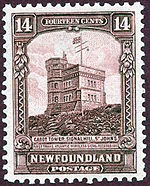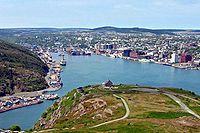.gif)
Cabot Tower (Newfoundland)
Encyclopedia
Cabot Tower is a tower in St. John's
, Newfoundland and Labrador
, situated on Signal Hill. Construction of tower begun in 1898 to commemorate the 400th anniversary of John Cabot's
discovery of Newfoundland
, and Queen Victoria's
Diamond Jubilee
.
In 1901, Guglielmo Marconi
received the first trans-Atlantic wireless message at a position near the tower, the letter "S" in Morse Code
sent from Poldhu
, Cornwall
, United Kingdom. Cabot Tower is now the centre of Signal Hill National Historic Park, Canada's second largest historic park, with walking trails, and an interpretation centre where the visitor can hear stories about the area.
, Cabot Tower was completed in 1900 and has been a part of a number of historic events. Although now one of the most recognizable symbols of St. John's and Newfoundland and Labrador, its construction was not well supported in the town. Most of St. John's burned to the ground in 1892 and the banks in Newfoundland crashed in 1894. When Judge D.W. Prowse
, a prominent local man, suggested building Cabot Tower, one person said in a local paper that "it's like putting a silk hat on the head of a man who can't afford to buy a pair of boots." Another project, the Victoria Wing of the local hospital, received much more public support.
 The building was used primarily for flag signalling. The British military first used Signal Hill, originally known as the Lookout, for this purpose in around 1704. There was a mast at the highest point on the hill, and it would be the job of a signalman to keep an eye out for ships approaching the city. When one was spotted he would indicate by flag what type of ship it was, what country it was from and fire off a peterra so that the men below in the town would know to look towards the hill. Then they would fire the same type of cannon in response. By the end of the 18th century, a blockhouse had been constructed on the site. By the 19th century, the signalling was done mostly for the various merchants who operated out of St. John's. Cabot Tower was the last in a line of signalling blockhouses built on Signal Hill, it was used for flag signalling until 1960.
The building was used primarily for flag signalling. The British military first used Signal Hill, originally known as the Lookout, for this purpose in around 1704. There was a mast at the highest point on the hill, and it would be the job of a signalman to keep an eye out for ships approaching the city. When one was spotted he would indicate by flag what type of ship it was, what country it was from and fire off a peterra so that the men below in the town would know to look towards the hill. Then they would fire the same type of cannon in response. By the end of the 18th century, a blockhouse had been constructed on the site. By the 19th century, the signalling was done mostly for the various merchants who operated out of St. John's. Cabot Tower was the last in a line of signalling blockhouses built on Signal Hill, it was used for flag signalling until 1960.
 On December 12, 1901, it stood witness to possibly the most important accomplishment in modern communications - the reception of the first wireless transatlantic signal by Guglielmo Marconi from his Poldhu Wireless Station, in Cornwall, England. A Marconi Wireless Station operated on the second floor of Cabot Tower for many years afterward. In fact, in 1920 one of the first wireless transatlantic transmissions of the human voice was made there. Men at the wireless station were able to talk with the steamship Victoria which was steaming out of England. The station operated until around 1960. The communications legacy of Cabot Tower is kept alive today by the Society of Newfoundland Radio Amateurs (or SONRA) who operate a ham radio station on the second floor.
On December 12, 1901, it stood witness to possibly the most important accomplishment in modern communications - the reception of the first wireless transatlantic signal by Guglielmo Marconi from his Poldhu Wireless Station, in Cornwall, England. A Marconi Wireless Station operated on the second floor of Cabot Tower for many years afterward. In fact, in 1920 one of the first wireless transatlantic transmissions of the human voice was made there. Men at the wireless station were able to talk with the steamship Victoria which was steaming out of England. The station operated until around 1960. The communications legacy of Cabot Tower is kept alive today by the Society of Newfoundland Radio Amateurs (or SONRA) who operate a ham radio station on the second floor.
 Located at the highest point of Signal Hill, overlooking the city and the ocean, Cabot Tower is an example of late-Gothic Revival style. built of irregularly coursed red sandstone
Located at the highest point of Signal Hill, overlooking the city and the ocean, Cabot Tower is an example of late-Gothic Revival style. built of irregularly coursed red sandstone
is composed of a two storey, 30 foot, square structure with a three storey, 50 foot octagonal tower that stands on the southeast corner of the building. The corners are buttressed at the first floor level and further emphasized through the use of heavier blocks of stone. On the main body of the building, at the top of the second storey level, is a line of repeating pattern like an exaggerated dentil row or inverted crenelations. The attached tower which houses the main entrance, is very plain with a double string course marking the divisions between second and third storeys and heavy corbel tables marking the eight corners of the turret at the flared upper level. The windows on both the corner turret and the body of the tower proper are rectangular and set under heavy stone lintels. Its architect, William Howe Greene was a prominent St. John's architect and an associate of the Royal Institute of British Architects.
St. John's, Newfoundland and Labrador
St. John's is the capital and largest city in Newfoundland and Labrador, and is the oldest English-founded city in North America. It is located on the eastern tip of the Avalon Peninsula on the island of Newfoundland. With a population of 192,326 as of July 1, 2010, the St...
, Newfoundland and Labrador
Newfoundland and Labrador
Newfoundland and Labrador is the easternmost province of Canada. Situated in the country's Atlantic region, it incorporates the island of Newfoundland and mainland Labrador with a combined area of . As of April 2011, the province's estimated population is 508,400...
, situated on Signal Hill. Construction of tower begun in 1898 to commemorate the 400th anniversary of John Cabot's
John Cabot
John Cabot was an Italian navigator and explorer whose 1497 discovery of parts of North America is commonly held to have been the first European encounter with the continent of North America since the Norse Vikings in the eleventh century...
discovery of Newfoundland
Newfoundland and Labrador
Newfoundland and Labrador is the easternmost province of Canada. Situated in the country's Atlantic region, it incorporates the island of Newfoundland and mainland Labrador with a combined area of . As of April 2011, the province's estimated population is 508,400...
, and Queen Victoria's
Victoria of the United Kingdom
Victoria was the monarch of the United Kingdom of Great Britain and Ireland from 20 June 1837 until her death. From 1 May 1876, she used the additional title of Empress of India....
Diamond Jubilee
Diamond Jubilee
A Diamond Jubilee is a celebration held to mark a 60th anniversary in the case of a person or a 75th anniversary in the case of an event.- Thailand :...
.
In 1901, Guglielmo Marconi
Guglielmo Marconi
Guglielmo Marconi was an Italian inventor, known as the father of long distance radio transmission and for his development of Marconi's law and a radio telegraph system. Marconi is often credited as the inventor of radio, and indeed he shared the 1909 Nobel Prize in Physics with Karl Ferdinand...
received the first trans-Atlantic wireless message at a position near the tower, the letter "S" in Morse Code
Morse code
Morse code is a method of transmitting textual information as a series of on-off tones, lights, or clicks that can be directly understood by a skilled listener or observer without special equipment...
sent from Poldhu
Poldhu
Poldhu is a small area in south Cornwall, England, UK, situated on the Lizard Peninsula; it comprises Poldhu Point and Poldhu Cove. It lies on the coast west of Goonhilly Downs, with Mullion to the south and Porthleven to the north...
, Cornwall
Cornwall
Cornwall is a unitary authority and ceremonial county of England, within the United Kingdom. It is bordered to the north and west by the Celtic Sea, to the south by the English Channel, and to the east by the county of Devon, over the River Tamar. Cornwall has a population of , and covers an area of...
, United Kingdom. Cabot Tower is now the centre of Signal Hill National Historic Park, Canada's second largest historic park, with walking trails, and an interpretation centre where the visitor can hear stories about the area.
History
Begun in 1898, to commemorate both Queen Victoria's Diamond Jubilee and the 400th anniversary of John Cabot's (Giovanni Caboto) voyage to the New WorldNew World
The New World is one of the names used for the Western Hemisphere, specifically America and sometimes Oceania . The term originated in the late 15th century, when America had been recently discovered by European explorers, expanding the geographical horizon of the people of the European middle...
, Cabot Tower was completed in 1900 and has been a part of a number of historic events. Although now one of the most recognizable symbols of St. John's and Newfoundland and Labrador, its construction was not well supported in the town. Most of St. John's burned to the ground in 1892 and the banks in Newfoundland crashed in 1894. When Judge D.W. Prowse
Daniel Woodley Prowse
Daniel Woodley Prowse was a lawyer, politician, judge, historian, essayist, and office holder.Born in Port de Grave, Newfoundland , he was the fourth of the seven children of Robert Prowse and Jane Woodley...
, a prominent local man, suggested building Cabot Tower, one person said in a local paper that "it's like putting a silk hat on the head of a man who can't afford to buy a pair of boots." Another project, the Victoria Wing of the local hospital, received much more public support.


Architectural value

Sandstone
Sandstone is a sedimentary rock composed mainly of sand-sized minerals or rock grains.Most sandstone is composed of quartz and/or feldspar because these are the most common minerals in the Earth's crust. Like sand, sandstone may be any colour, but the most common colours are tan, brown, yellow,...
is composed of a two storey, 30 foot, square structure with a three storey, 50 foot octagonal tower that stands on the southeast corner of the building. The corners are buttressed at the first floor level and further emphasized through the use of heavier blocks of stone. On the main body of the building, at the top of the second storey level, is a line of repeating pattern like an exaggerated dentil row or inverted crenelations. The attached tower which houses the main entrance, is very plain with a double string course marking the divisions between second and third storeys and heavy corbel tables marking the eight corners of the turret at the flared upper level. The windows on both the corner turret and the body of the tower proper are rectangular and set under heavy stone lintels. Its architect, William Howe Greene was a prominent St. John's architect and an associate of the Royal Institute of British Architects.

